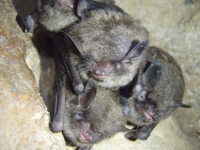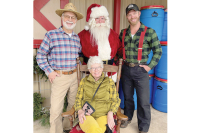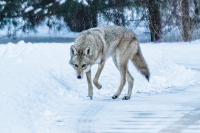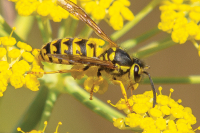Getting at the nitty gritty of history
 Regional histories are my favorite literary genre. It’s in them that the nitty-gritty of everyday life is most clearly portrayed. Dr. H.G. Jones’ Scoundrels, Rogues and Heroes of the Old North State (Charleston SC: The History Press, 2005, soft cover, 128 pp., $16.99), edited by K. Randell Jones and Caitlin D. Jones, is a collection of more than 50 such essays. They were selected from a body of work that appeared as a weekly series of columns titled “In the Light of History” published by the Associated Press in newspapers across North Carolina from 1969 to 1986.
Regional histories are my favorite literary genre. It’s in them that the nitty-gritty of everyday life is most clearly portrayed. Dr. H.G. Jones’ Scoundrels, Rogues and Heroes of the Old North State (Charleston SC: The History Press, 2005, soft cover, 128 pp., $16.99), edited by K. Randell Jones and Caitlin D. Jones, is a collection of more than 50 such essays. They were selected from a body of work that appeared as a weekly series of columns titled “In the Light of History” published by the Associated Press in newspapers across North Carolina from 1969 to 1986.
Sourwood honey is a favorite among connoisseurs
 Now is sourwood time. From late June into mid-August sourwood trees will be flowering throughout Western North Carolina, from the lowest elevations to almost 5,000 feet. Here, then, more or less at random, are some notes from my sourwood file:
Now is sourwood time. From late June into mid-August sourwood trees will be flowering throughout Western North Carolina, from the lowest elevations to almost 5,000 feet. Here, then, more or less at random, are some notes from my sourwood file:
Confederates pushed road over Newfound Gap
On Jan. 12, 1864, a Confederate battery of artillery and about 650 men under the command of Gen. Robert B. Vance crossed the Smokies at Indian Gap — situated at 5,317 feet between Clingmans Dome and Newfound Gap along the high divide between North Carolina and Tennessee — in an attempt to secure provisions, screen the main approaches to North Carolina, and guard the left flank of the Longstreet’s main Confederate force at Greeneville, Tenn.
Some ‘Indian Caves’ were very likely the real thing
 Everywhere you go in Western North Carolina there are secluded places reputed to have been used as hideaways by the 500 or so Cherokees seeking refuge during the removal era of the late 1830s. Most of these legends are oft-told tales connected to dank holes in the ground.
Everywhere you go in Western North Carolina there are secluded places reputed to have been used as hideaways by the 500 or so Cherokees seeking refuge during the removal era of the late 1830s. Most of these legends are oft-told tales connected to dank holes in the ground.
The black sheep of the blackbird family
 2014 seems to be a banner year for cowbirds. I saw them in large numbers in southeastern Arizona two weeks ago. And this past weekend they were also prominent around Bryson City and along the Blue Ridge Parkway here in the Smokies region.
2014 seems to be a banner year for cowbirds. I saw them in large numbers in southeastern Arizona two weeks ago. And this past weekend they were also prominent around Bryson City and along the Blue Ridge Parkway here in the Smokies region.
Some folks can’t stand house sparrows (a native of north Africa and Eurasia), while others detest starlings (a native of Europe). Both species were introduced into this country in the 19th century. While I don’t especially admire house sparrows and starlings, my favorite bird to despise is the brown-headed cowbird, a native of North America.
A few poems as spring awakens the mountains
Since the year 2000, I have written going on 750 Back Then “columns” for The Smoky Mountain News. I am enormously proud of that association. Many of the “essays” in my books have been filtered through SMN to their benefit. Even though I have always thought of myself as a poet, only four or five of the BT pieces have contained verse.
Behind the ballad of Kidder Cole
 Judge Felix E. Alley (1873-1957) was a native of Whiteside Cove, near Cashiers and Highlands. During most of his legal career as an attorney and superior court judge, he resided in Waynesville and served, on occasion, as the attorney for Swain and other counties. He was the author of Random Thoughts and the Musings of a Mountaineer (1941).
Judge Felix E. Alley (1873-1957) was a native of Whiteside Cove, near Cashiers and Highlands. During most of his legal career as an attorney and superior court judge, he resided in Waynesville and served, on occasion, as the attorney for Swain and other counties. He was the author of Random Thoughts and the Musings of a Mountaineer (1941).
Regional historians and ‘piglets from heaven’
“Eagles, as they still do, lived on the creek. One day in the 1890s, an eagle dropped a piglet into the yard of Orville Welch, who was living on Ecoah Branch on Eagle Creek. He kept this strange gift from the heavens, not knowing where the eagle had gotten it, and it grew into a fine hog.”
— Duane Oliver, Hazel Creek from Then Till Now
Another storyteller to add to the list
For years I’ve been enjoying and sometimes writing about a group of old-time Western North Carolina storytellers I think of collectively as “The Mountain Humorists.” These weren’t professional storytellers in the sense that they made formal appearances for pay or aspired to produce books. They were individuals located in various counties during the late 19th and early 20th centuries who could be counted upon to tickle their neighbors’ funny bones on a regular basis with either tall tales or humorous observations.
A bear hunter for the ages
John Baker (Little John) Cable Jr. is one of the prominent figures in Horace Kephart’s Our Southern Highlanders (1913; revised and expanded in 1922). He steals the show in Chapter 4 (“A Bear Hunt in the Smokies”), which most everybody — including those who don’t care much for other parts of the book — agrees is a fine piece of writing.









